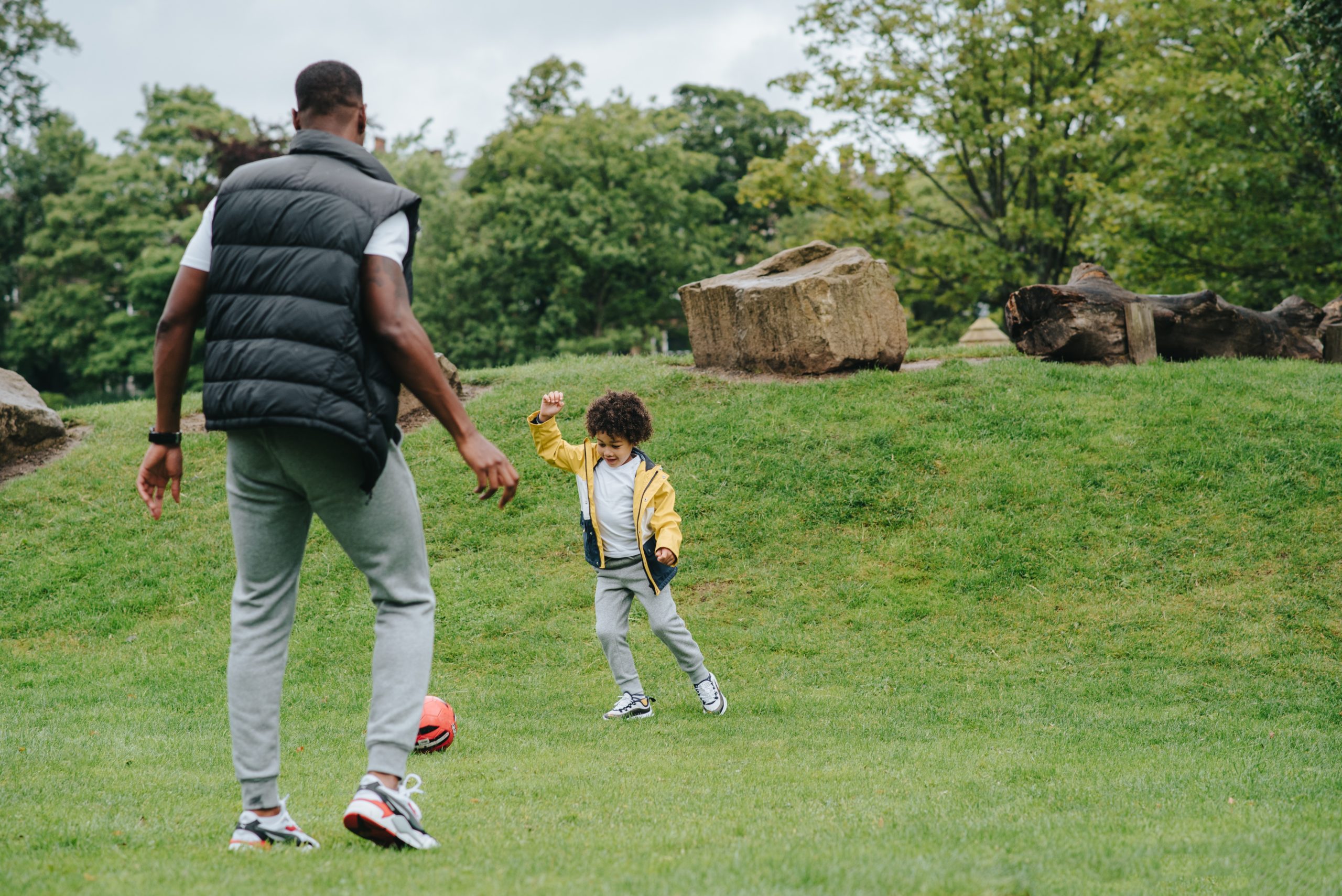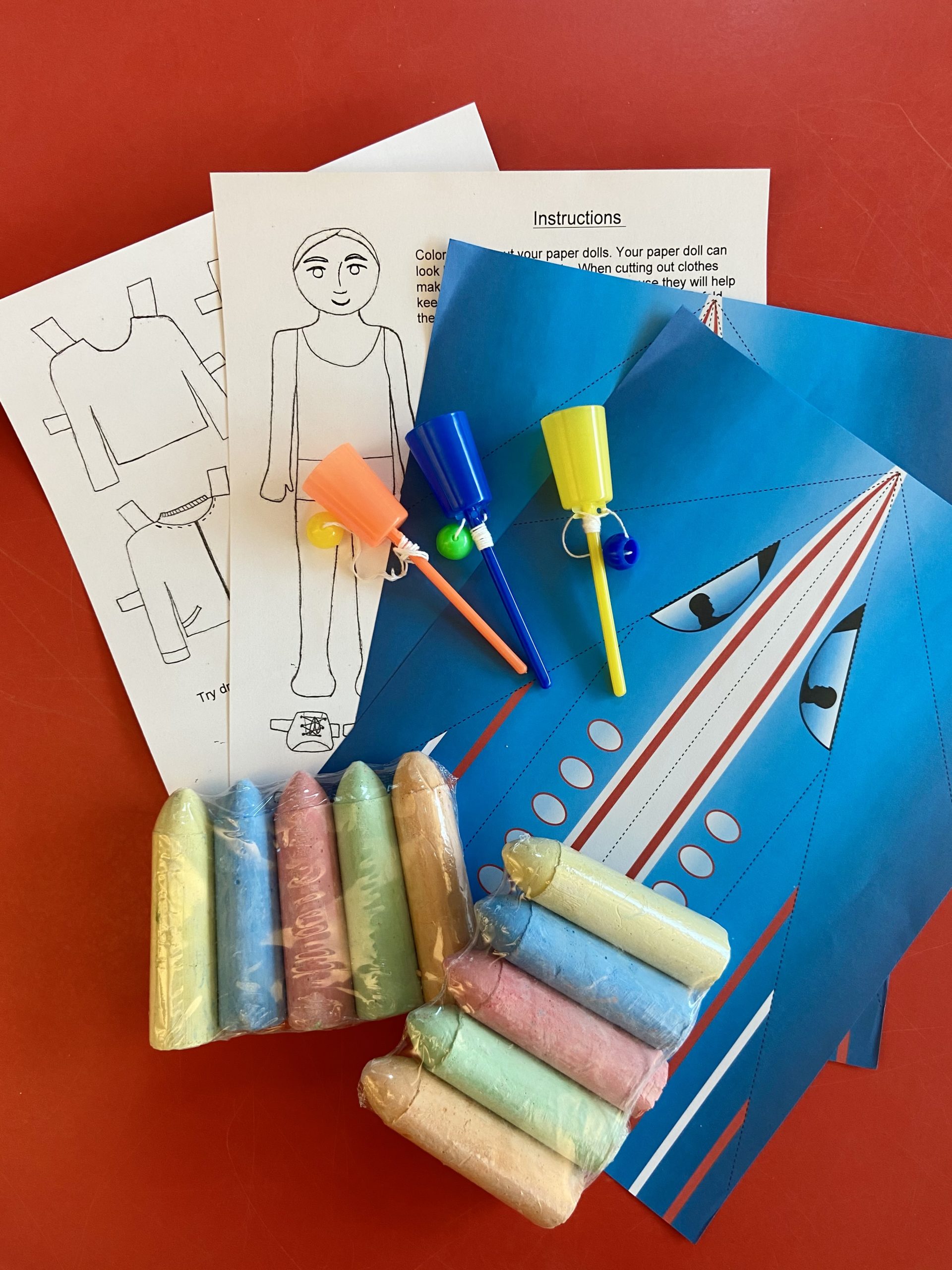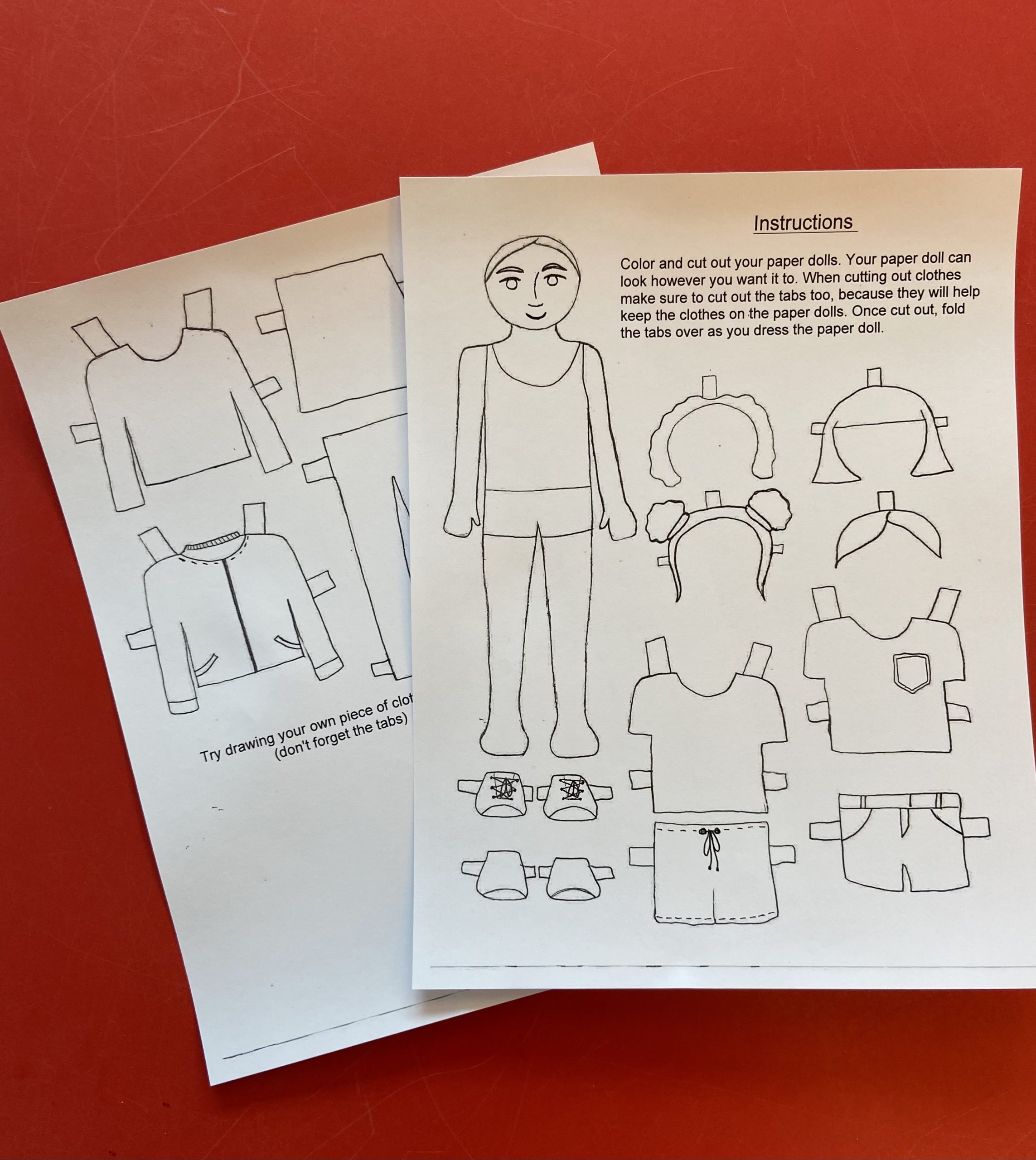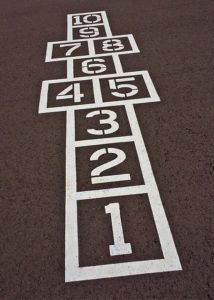
Why Play Folk Games?
Folk games teach cooperative play and understanding.
Kids learn to work together and play by the rules so that everyone has a good time.
Folk games can also be changed to meet the needs of the group, and family or friend group variations and special rules are common.
Fresh air, exercise, and being outside in nature. There are so many positive things about playing folk games!
Folk games, also known as classic or traditional games, are activities children teach each other and are passed down between generations.
Remember hearing Grandpa talk about tin can stilts or chasing a hoop with a stick when he was young? Or maybe your Mom played hopscotch or jump rope with her friends at recess back in elementary school? These are all examples of folk games!
One of the great things about folk games is that they are usually inexpensive to play because you don’t need very many materials or the materials can be “found” (like a stick or a ball or chalk). This makes it easy to play without much preparation, and without the need for a lot of equipment. Scroll down to the bottom of this page to find our collection of folk games, rules, and resources.
Playing Folk Games
For many folk games all you need is a few people and an open space. Others, like jump rope or hopscotch, just need one or two tools. This makes these games an easy activity to get everyone moving and playing together. Many have some level of competition, which will make them fun to play again and again to see who wins.
While winning may seem like the main goal of many folk games, kids are also learning about following the rules, working together, and how to be a good sport when they lose or win. These games also promote physical activity and can be great ways to build gross motor skills like hand-eye coordination and jumping.
Our Folk Games kit from the library is designed to get you started with a few simple, and screen free, activities. The kit includes one ball and cup game, one foldable paper airplane, one set of paper dolls to color and cut out, chalk for sidewalk games like hopscotch, and instructions for a number of outdoor games to play with your family. Click the button below to reserve your kit.
Paper Dolls
Paper dolls are another children’s activity that has largely been replaced with digital counterparts. However, they can still be a fun screen-free alternative. Designing, dressing up, and playing with paper dolls is a fun and easy activity. You can find premade paper dolls and templates online or for sale. However, you can also always make your own! Designing your own doll, and the clothes they wear, means your doll will be just what you wanted. Coloring and cutting out the dolls will also help kids work on their fine motor skills.
One of our librarians designed some simple paper dolls that kids can color in and cut out themselves. The dolls are included in the library kit. However, if you missed the kit, you can also print out a PDF of the dolls right from this page.
Note: Card stock is recommended (but not required) for paper dolls.


Folk Games To Play With Family
Just click on any of the games below for instructions on how to play.
Hand Clapping Games
Hand clapping games are super fun rhythmic games and all you need are your hands! Hand clapping games usually consist of a rhyme or song that is sung while players clap along. The rhyme or song is then repeated at a faster and faster pace until someone messes up the clapping pattern. As kids get better they will be able to go faster and faster. Playing hand clapping games is a great way for kids to work on their fine motor skills and their attention to rhythm and rhyme.
Hand clapping games have been played around the world for a very long time. This means there are many, many, variations and different types of rhymes and songs. We have collected a few resources to get you started.
If you are interested get started with this amazing article from the New York Times about hand clapping games around the world.
- For even more rhymes check out this article (includes videos): 10 classic hand-clapping games to teach your kid
- This website has simple hand clapping games in Spanish: 10 Spanish Hand Clapping Games for Language Learners
Cat's Cradle
Cat’s Cradle is an incredibly portable game can be played anywhere. It can by played alone or with a partner. Needs a long piece of string or yarn, knotted together to form a loop. Because the game is hard to explain through text instructions check out the very short video below, or this slightly longer video to learn how to play.
If you are playing alone, you can make various string shapes on your own hands. With two people, you can play a bit of a game, transferring the shapes back and forth and creating new ones. There are many different string game variations. Check out this book from our collection to learn more.
Hoop Pass
Hoop Pass is a fun game that combines team work and problem solving. The game can be played as a group game or as two competing teams. You will need one or two hula hoops for the game, depending on if you are playing as one or two groups. Watch this quick tutorial.
If you are playing as one cooperative team follow the instructions with only one team. If you are working together your goal can be to complete the circle as fast as possible. Then try to beat your time.
- Divide players into two teams, each with an equal number of players. Teams stand with team members lined up side by side, holding hands. Or the players can form a circle and hold hands.
- Give the team member at the start of each line a hula hoop to hold in their free hand. On ‘Go’ team members must pass the hoop over their bodies and along the line, without dropping hands (ie. the need to step through the hoop and pass it along to the next team member). The first team to get their hoop to the end is the winning team!
(Source: https://childhood101.com/birthday-party-games-for-kids/)
Hopscotch
Hopscotch helps develop our gross motor skills and practice our balance. You will need sidewalk chalk and an open space you can draw on (sidewalk, driveway, etc.). Check out a video on how to play here, or read our instructions below.
Instructions:
- If playing outside, draw a traditional hopscotch diagram with chalk, like the one pictured here.

- Throw a small stone, twig, beanbag, or other marker into the first square. (If it lands on a line, or outside the square, you lose your turn. Pass the marker to the next player and wait for your next turn.)
- Hop on one foot into the first empty square, and then every following empty square. Be sure to skip the one your marker is on.
- At the squares that are pairs (4-5 and 7-8), jump with both feet.
- At 10, hop with both feet, turn around, and head back toward the start.
- When you reach the marked square again, pick up the marker—still on one foot!—and complete the course.
- If you finished without any mistakes, pass the marker to the next player. On your next turn, throw the marker to the next number.
- If you fall, jump outside the lines, or miss a square or the marker, you lose your turn and must repeat the same number on your next turn. Whoever reaches 10 first, wins!
Jump Rope
Jump rope has endless variations and so many rhymes! It is a great way to learn rhythm and work on jumping and coordination. All you need is a piece of rope. Watch this tutorial for basic instructions.
There are so many rhymes and games that use jump rope that we couldn’t possibly collect them all. Here we have links to a few to get you started:
- Jump Rope Rhymes from Jane Chien: https://youtu.be/rucp0rWs4pU
- Jump Rope Rhymes from Move It Monday with Mrs Mohamed: https://youtu.be/ikAXRogSV-A
- Jump Rope Songs from Sally Haines: https://youtu.be/8eBxbbF3YHk
Or find a book of jump rope rhymes right here at YDL! Check out Anna Banana : 101 jump-rope rhymes or Miss Mary Mack and other children’s street rhymes in our catalog.
Jump Rope Instructions:
- Put the handles of the jump rope into each hand. If you do not have a ready made jump rope, any heavier cord or rope will work. If you stand on the curve of the rope, it should reach from ear to ear (from foot to ear) to have the proper length. Begin with the jump rope behind your body.
- Next, swing the jump rope gently over your head to the front of your body and then to the back. Practice this several times just swinging the rope from the front to the back.
- Now swing the jump rope to the front and let it stay on the ground. Keep the rope still and jump over it. Practice this step several times.
- The next step is to swing the jump rope to the front of your body and when it gets close to your feet, JUMP over it! It takes practice to get the timing just right.
(Source: https://theinspiredtreehouse.com/teaching-your-child-how-to-jump-rope/)
Kick The Can
Instructions:
- One person or a team of people are designated as “it” and a can (or ball) is placed in the middle of the playing area.
- The other people run off and hide while the “it” covers their eyes and counts to a certain number. “It” then tries to find everyone.
- If a person is tagged by “it”, they go into a holding pen for captured players. The pen is decided upon before the game. It should be somewhere close, but not to close, to the can or ball.
- When there are players in the holding pen other free players may try to set them free. They can leave their hiding place and try to sneak up to the can or ball without “it” tagging them.
- If one of the free players manages to kick the can, the captured players are released and can run and hide again.
- The game is over once all the non-“it” players are in the holding pen.
(Source: https://www.wired.com/2009/08/simpleoutdoorplay/)
Red Light, Green Light
Red Light, Green Light is a great game to work on listening and gross motor skills. Watch this video or find the instructions below.
- One person is chosen to be “it” (the traffic light) and they stands a good distance away from the other players (15+ feet) with their back to them. The other players stand in a line facing “it”.
- When “it” calls ‘Green Light,’ the other players move towards “it” until they spins around, calling ‘Red Light.’ When the other players hear the red light command the the players must freeze on the spot. Anyone seen moving must return to the starting line. The children must remain frozen until the next ‘Green Light’ command is given.
- Play continues in this manner until someone reaches and tags “It”. The tagger becomes the new “it” and the game begins again.
Variations:
- Include a ‘Yellow Light’ command which requires the players to move in slow motion.
- Decide if shouting ‘Red Light’ more than once in a row is allowed as this will certainly get players listening.
- Before calling ‘Green Light,’ “it” or the supervising adult selects a way of moving – hopping, crawling, walking backwards, etc
- A simpler version for younger children involves the “it” stays facing the other players.
(Source: https://childhood101.com/games-for-kids-red-light-green-light/)
Red Rover
Red Rover is a very active group game. It requires no materials, but does work better with a larger group. Because of this we recommend playing this game when social distancing is no longer necessary. Learn to play by watching the videos, or read the instructions below.
- Divide into two teams. Teams spread out and form two parallel lines, facing each other.
- Taking turns, one team links their hands and calls one player over.
- The chosen friend runs as fast possible to try and break the other teams hold.
- If successful, the player picks one person and brings them back to his/her team.
- If not successful, the player has to join the other team.
- The team with the most players WINS!
(Source: https://www.gogosqueez.com/get-up-and-gogo/red-rover/)
Sardines
Sardines is a game very similar to Hide-and-Seek, but in reverse. It has one person hide while the others try to find them, and then hide with them. By the end of the game the hiders begin to resemble a bunch of squashed sardines!
This game requires at least three people to play it and there is no material involved.
Instructions:
- One person is chosen to be the hider. That person is given time (usually a couple of minutes) to find a place to hide inside the area agreed upon.
- When they are hidden everyone else begins to look for that one hidden person. When someone finds the hidden person, they quietly join them in hiding in the same spot (Hint: When hiding it is good to think about how many people might be able to hide with you).
- This continues until there is only one seeker left. The object of the game is to not be the last seeker. The last seeker, the person who didn’t find the hider, becomes the next hider.
Simon Says
Simon Says is a great way to practice our listening skills. It is also really easy to play, no supplies needed!
Instructions:
- One person is the leader and calls out the actions. Everyone else must follow the leader and do the action, but only when Simon says. For example, “Simon says, touch your toes.” Everyone must touch their toes.
- Then the leader has to try and get everyone to do an action without saying Simon says. If someone does the action and the leader did not say “Simon says,” that person is out of the game. For example, if the leader says just “touch your toes” and someone touches their toes, they are out of the game.
- The leader can try to make things more difficult by speeding up the pace of calling out the actions.
- The game ends when there is only one person left. That person becomes the new Simon.
(Source: https://www.thebestideasforkids.com/simon-says-ideas)

